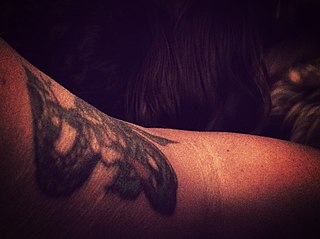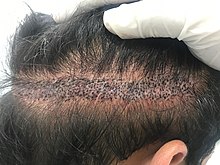
Hair loss, also known as alopecia or baldness, refers to a loss of hair from part of the head or body. Typically at least the head is involved. The severity of hair loss can vary from a small area to the entire body. Inflammation or scarring is not usually present. Hair loss in some people causes psychological distress.
Tissue expansion is a technique used by plastic, maxillofacial and reconstructive surgeons to cause the body to grow additional skin, bone, or other tissues. Other biological phenomena such as tissue inflammation can also be considered expansion.

The scalp is the anatomical area bordered by the human face at the front, and by the neck at the sides and back.

A facelift, technically known as a rhytidectomy, is a type of cosmetic surgery procedure used to give a more youthful facial appearance. There are multiple surgical techniques and exercise routines. Surgery usually involves the removal of excess facial skin, with or without the tightening of underlying tissues, and the redraping of the skin on the patient's face and neck. Exercise routines tone underlying facial muscles without surgery. Surgical facelifts are effectively combined with eyelid surgery (blepharoplasty) and other facial procedures and are typically performed under general anesthesia or deep twilight sleep.
The management of hair loss, includes prevention and treatment of alopecia, baldness, and hair thinning, and regrowth of hair.

Permanent makeup, also known as permanent cosmetics, derma-pigmentation, micro-pigmentation, and cosmetic tattooing, is a cosmetic technique which employs tattoos as a means of producing designs that resemble makeup, such as eye-lining and other permanent enhancing colors to the skin of the face, lips, and eyelids. It is also used to produce artificial eyebrows, particularly in people who have lost them as a consequence of old age, disease, such as alopecia totalis, chemotherapy, or a genetic disturbance, and to disguise scars and hypopigmentation in the skin such as in vitiligo. It is also used to restore or enhance the breast's areola, such as after breast surgery.

Hair transplantation is a surgical technique that removes hair follicles from one part of the body, called the 'donor site', to a bald or balding part of the body known as the 'recipient site'. The technique is primarily used to treat male pattern baldness. In this minimally invasive procedure, grafts containing hair follicles that are genetically resistant to balding are transplanted to the bald scalp.

Tattoo removal is the process of removing an unwanted tattoo. The process of tattooing generally creates permanent markings in the skin, but people have attempted many methods to try to hide or destroy tattoos.

Pattern hair loss (also known as androgenetic alopecia (AGA)) is a hair loss condition that primarily affects the top and front of the scalp. In male-pattern hair loss (MPHL), the hair loss typically presents itself as either a receding front hairline, loss of hair on the crown (vertex) of the scalp, or a combination of both. Female-pattern hair loss (FPHL) typically presents as a diffuse thinning of the hair across the entire scalp.
Follicular unit transplantation (FUT) is a hair restoration technique, also known as the strip procedure, where a patient's hair is transplanted in naturally occurring groups of 1 to 4 hairs, called follicular units. Follicular units also contain sebaceous (oil) glands, nerves, a small muscle, and occasional fine vellus hairs. In follicular unit transplantation, these small units allow the surgeon to safely transplant thousands of grafts in a single session, which maximizes the cosmetic impact of the procedure.
Follicular unit extraction is one of two primary methods of obtaining hair follicles, naturally occurring groups of one to four hairs, for hair transplantation. The other method is called strip harvesting. In 2018, Mejia published the updated guidelines adopted by the International Society of Hair Restoration Surgery. This name change came about to accurately describe the procedure which involves surgically cutting or incising a full thickness hair follicle skin graft with a circular scalpel, punch or motorized drill and subsequently carefully extracting it from the scalp to be placed in the donor balding scalp. Due to the new developments of incision punches and devices and a variety of different extraction techniques, it was necessary to more accurately define the procedure. Additionally, many places were incorrectly marketing the extraction procedure as a simple plucking of hairs and deceiving the public.

Discoid lupus erythematosus is the most common type of chronic cutaneous lupus (CCLE), an autoimmune skin condition on the lupus erythematosus spectrum of illnesses. It presents with red, painful, inflamed and coin-shaped patches of skin with a scaly and crusty appearance, most often on the scalp, cheeks, and ears. Hair loss may occur if the lesions are on the scalp. The lesions can then develop severe scarring, and the centre areas may appear lighter in color with a rim darker than the normal skin. These lesions can last for years without treatment.
Madarosis is a condition that results in the loss of eyelashes, and sometimes eyebrows. The term "madarosis" is derived from the ancient Greek "madaros", meaning "bald". It originally was a disease of only losing eyelashes but it currently is the loss of both eyelashes and eyebrows. Eyebrows and eyelashes are both important in the prevention of bacteria and other foreign objects from entering the eye. A majority of patients with madarosis have leprosy, and it was reported that 76% of patients with varying types of leprosy had madarosis.
Non scarring hair loss, also known as noncicatricial alopecia is the loss of hair without any scarring being present. There is typically little inflammation and irritation, but hair loss is significant. This is in contrast to scarring hair loss during which hair follicles are replaced with scar tissue as a result of inflammation. Hair loss may be spread throughout the scalp (diffuse) or at certain spots (focal). The loss may be sudden or gradual with accompanying stress.
Aesthetic medicine is a branch of modern medicine that focuses on altering cosmetic appearance through the treatment of conditions including scars, skin laxity, wrinkles, moles, liver spots, excess fat, cellulite, unwanted hair, skin discoloration, and spider veins. Traditionally, it includes dermatology, oral and maxillofacial surgery, reconstructive surgery and plastic surgery, surgical procedures, non-surgical procedures, and a combination of both. Aesthetic medicine procedures are usually elective. There is a long history of aesthetic medicine procedures, dating back to many notable cases in the 19th century, though techniques have developed much since then.
Norman Orentreich was a New York dermatologist and the father of modern hair transplantation.

The process or technique of tattooing, creating a tattoo, involves the insertion of pigment into the skin's dermis. Traditionally, tattooing often involved rubbing pigment into cuts. Modern tattooing almost always requires the use of a tattoo machine and often procedures and accessories to reduce the risk to human health.
Hairline lowering is a surgical technique that allows an individual to have their frontal hairline advanced certain distances depending on variables such as pre-operative hairline height, scalp laxity, and patient preference. It can be used to address a congenitally high hairline or sometimes a hairline that has recessed from hair loss. It is performed mostly on women.
Hair multiplication or hair cloning is a proposed technique to counter hair loss. The technology to clone hair is in its early stages, but in October 2022, scientists from Yokohama National University successfully cloned fully mature hair follicles in mice.
Scalp reduction is a surgical procedure in which the hairless region of the scalp of a bald man is reduced. This procedure can reduce the area of the scalp in which hair transplantation is needed, or even eliminate the need for hair transplantation.










